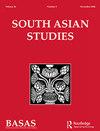Mughal Tilework: Derivative or Original?
IF 0.7
0 ASIAN STUDIES
引用次数: 2
Abstract
Although concentrating on Mughal tilework, this paper also discusses its predecessors elsewhere in the Islamic world, particularly in Iran, Central Asia, and Sultanate India. A brief survey of the development of the main techniques, namely monochrome-glazed tiles, sgraffito, tile mosaic, underglaze-painted and cuerda seca, both in Sultanate India and in other parts of the Islamic world, precedes the discussion of Mughal examples in the body of the paper. The paper highlights the initial links with Sultanate tilework, whether underglaze-painted, as in the Punjab, or with tile mosaic, in northern India. The development of Mughal tile mosaic is emphasized, as this was the medium most frequently used for tile decoration. Changes in the colour palette and in the introduction of new patterns are examined, highlighting the extensive use of figural imagery at the Lahore Fort and the simultaneous introduction of naturalistic vegetal panels. The less-frequent Mughal use of underglaze-painted and cuerda seca tiles is also examined. The conclusions summarize the characteristic features of Mughal tilework and suggest areas for future study.莫卧儿瓷砖:衍生品还是原创?
虽然集中在莫卧儿瓷砖,本文也讨论了它的前辈在伊斯兰世界的其他地方,特别是在伊朗,中亚,和苏丹国印度。简要介绍了主要技术的发展,即单色琉璃瓦,sgraffito,瓷砖马赛克,釉下彩绘和cuerda seca,在印度苏丹国和伊斯兰世界的其他地区,在论文主体讨论莫卧儿王朝的例子之前。这篇论文强调了与苏丹国瓷砖的最初联系,无论是旁遮普的釉下彩绘,还是印度北部的瓷砖马赛克。莫卧儿瓷砖马赛克的发展被强调,因为这是最常用于瓷砖装饰的媒介。对调色板的变化和新模式的引入进行了检查,突出了拉合尔堡人物形象的广泛使用,同时引入了自然主义的植物面板。莫卧儿王朝较少使用釉下彩绘和cuerda seca瓷砖也进行了研究。结论总结了莫卧儿瓷砖的特点,并提出了今后的研究方向。
本文章由计算机程序翻译,如有差异,请以英文原文为准。
求助全文
约1分钟内获得全文
求助全文

 求助内容:
求助内容: 应助结果提醒方式:
应助结果提醒方式:


